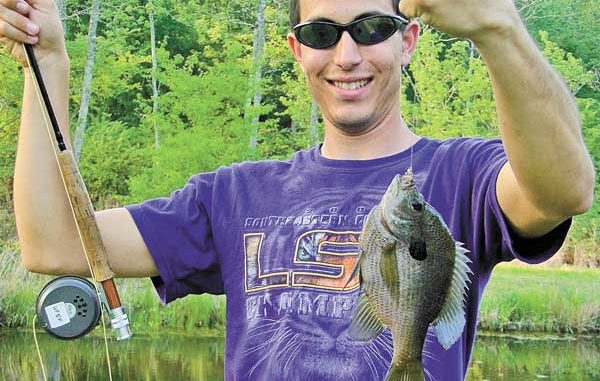
The Louisiana state fish is something special.
Several recent late-night tying sessions have exposed me to the countless television infomercials that appear after midnight.
There’s a kitchen knife collection from Ronco, Mr. T promoting a portable ultrasonic oven, Victoria Principal touting anti-aging cosmetics and Bobby Goldsboro hosting a best of the 1960s CD collection.
But my favorite features author Kevin Trudeau discussing his most recent book, Natural Cures They Don’t Want You To Know About.
And who is “they?” They are the government, the media, mega-corporations, Mormons, Girl Scouts — you name it. It’s all one grand conspiracy!
It got me to thinking — which is always dangerous — that perhaps I should reveal some techniques about bream fishing they don’t want you to know about.
The book, when published, will be free. Just send me three easy payments of $29.99 to cover postage.
In the meantime, you might want to know some details, as the peak season is here.
Let’s start with leaders. We all know that the best leader is one that is tapered, with a larger diameter butt section connected to the fly line and the thinnest section tied to the fly. Such a leader efficiently transfers energy from the line to the fly.
However, commercial leaders are very thick in the butt end — usually rated about 40 pounds. And they remain fairly thick until a few inches above the end of the tippet. When fishing weighted flies, these leaders sink so slow that most trout anglers add split shot to the leader to get them down faster.
Instead of adding split shot, I simply make a lighter leader. I use a 60/40 combination of 13-pound material for the butt and 4x material for the tippet. Given that jitterbees, fluff butts, tussel bugs and other weighted bream flies are a bit heavier than weighted trout flies, this is all you need to get them down quickly to where Mr. Stumpknocker lives.
Even for surface flies like popping bugs and foam spiders, a thinner leader can help. It adds more “limpness.” This allows one to impart tiny movements to a bug without skirting it several inches across the surface.
The best part is that do-it-yourself leaders are cheaper. A commercial leader is $4. Leader/tippet material costs the same, but comes with 30 feet on a spool. So for $12, you could buy three leaders, or you could make nine leaders. Personally, I prefer saving money.
On a recent trip to Lake Concordia, I was fishing a black/chartreuse jitterbee about 30 inches under a strike indicator. When I encountered bream, the bite was so soft the strike indicator would bobble or dance, but seldom go down on the first strike. I had to tease ever so slowly. You’d think it was tiny bream, the way the indicator was barely moving. Au contrare, Robespierre! Most of the time when I set the hook it was a bluegill or chinquapin (redear) 7 to 8 inches in length and quite fat.
However, I was missing quite a few fish. I rectified that by replacing the beadhead fly with a jighead version of the fly. Purists reading this will condemn me, for sure. But you can tie the same flies that you use a beadhead with, instead using a 1/80 or 1/100 ounce jighead.
Jigheads add a bit more weight, but more importantly, they position the fly more horizontal to the tippet. When bream are pecking at flies, they sit behind it instead of rising up to it. Their approach is the reason the fly gets hit and not eaten. A horizontal alignment of the fly eliminates this problem.
Just be aware that any fish caught on a jighead fly is ineligible for state or world records.
Another technique I learned from my late friend, Tony Accardo. Accardo Poppers have graced the walls of countless sporting-goods stores over the years. He’s not only in the Louisiana Outdoors Hall of Fame, but also considered one of the great legends of warmwater fly fishing.
Tony’s favorite method for catching big bream in the Atchafalaya Spillway was to use a popper and dropper rig. When the fish were on, it wasn’t uncommon for “doubles” where both flies had bream on at the same time.
If you fish such a rig, you want to make a somewhat arching cast, in contrast to a tight loop that is often preached in casting. That’s so the flies don’t get tangled up.
Surface-dropper combinations are widely used in coldwater fishing, particularly with hoppers and prince nymphs on such fabled waters as Montana’s Madison River. But for some odd reason I can’t explain, such practice is frowned upon by many warmwater fly fishers. It’s the reason why IGFA rules do not allow fish caught by this method to be entered for world records.
This last secret will certainly land you in the Fly Fishing Hall of Shame. I learned from my years as a bass tournament angler that bream love to peck at plastic worms. So to locate deep-water bream, I often use an ultralight spinning rod and a 4-inch plastic worm.
This technique has an added bonus: You’ll sometimes catch bass, and even big ones. Goggleyes, crappie, even catfish have also come into my boat while “prospecting.”
If you have any secrets to catching bream on fly rod, send them to catch@laflyfish.com and I’ll share them with readers.


